Being a successful artist is not Judy Chicago’s primary goal. She abandoned that ambition six decades ago when the Los Angeles art world greeted her with hostility. Now she’s having the last laugh, though. At 84 she is being heaped with accolades, including induction into America’s National Women's Hall of Fame, and is enjoying worldwide celebrity.
Currently filling four floors of the New Museum in New York, for instance, is Herstory, a major retrospective of her work. Which explains why the Serpentine Gallery survey feels a bit thin; inevitably, this show is only an echo of the full-bodied retro.
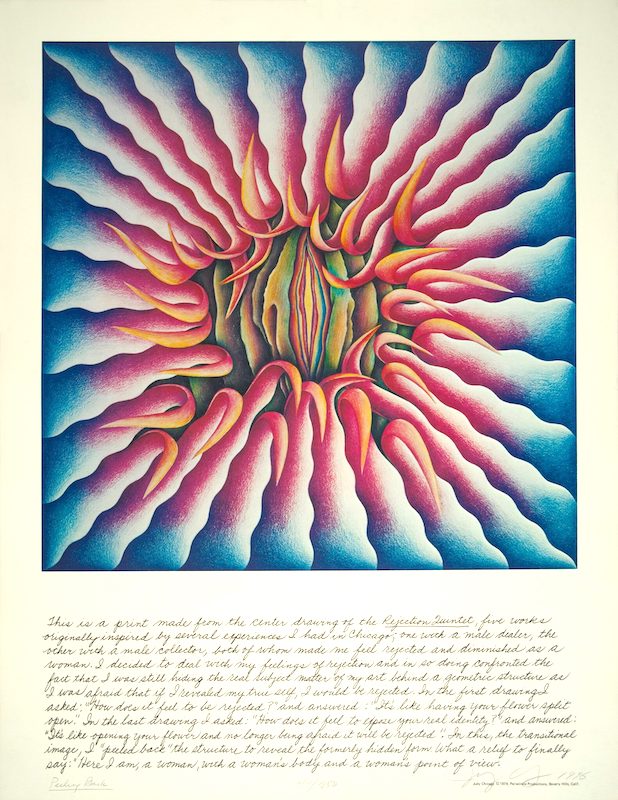 Chicago’s work is best understood as a provocation, an invitation to imagine how things could be improved and encouragement to get on the case. Begun in 2022, What If Women Ruled the World? is a series of banners embroidered by students at the Chanakya School of Craft in Mumbai, a nonprofit organisation teaching women skills traditionally practiced by men. At the Serpentine it appears in the form of a quilt embroidered with answers to the question (main picture) and a booth where you are invited to record your hopes for a better world.
Chicago’s work is best understood as a provocation, an invitation to imagine how things could be improved and encouragement to get on the case. Begun in 2022, What If Women Ruled the World? is a series of banners embroidered by students at the Chanakya School of Craft in Mumbai, a nonprofit organisation teaching women skills traditionally practiced by men. At the Serpentine it appears in the form of a quilt embroidered with answers to the question (main picture) and a booth where you are invited to record your hopes for a better world.
Chicago was radicalised in the 1960s by negative responses to her feminist version of minimalism. On show are the geometric abstractions she made soon after graduating from the University of California in 1964. Hard-edges are softened by glowing candy colours and, soon, straight lines began to morph into ripples and furls.
The Reincarnation Triptych, 1973 pays homage to three women from history. Delicate ripples flow inward towards a luminescent core; the design for Madame de Stael is framed with a hand written dedication acknowledging her as an “outstanding intellectual and philosopher of the eighteenth century” while Virginia Wolf is celebrated as the “first woman to forge a female form language in literature..”
Made in response to the reception she got from dealers and collectors, the Rejection Quintet 1974 of drawings has lengthy captions explaining that rejection is “like having your flower split open.” In Peeling Back (pictured right) ripples have fattened into fleshy tendrils turning pink as though in anger and curling up to expose vaginal folds beneath.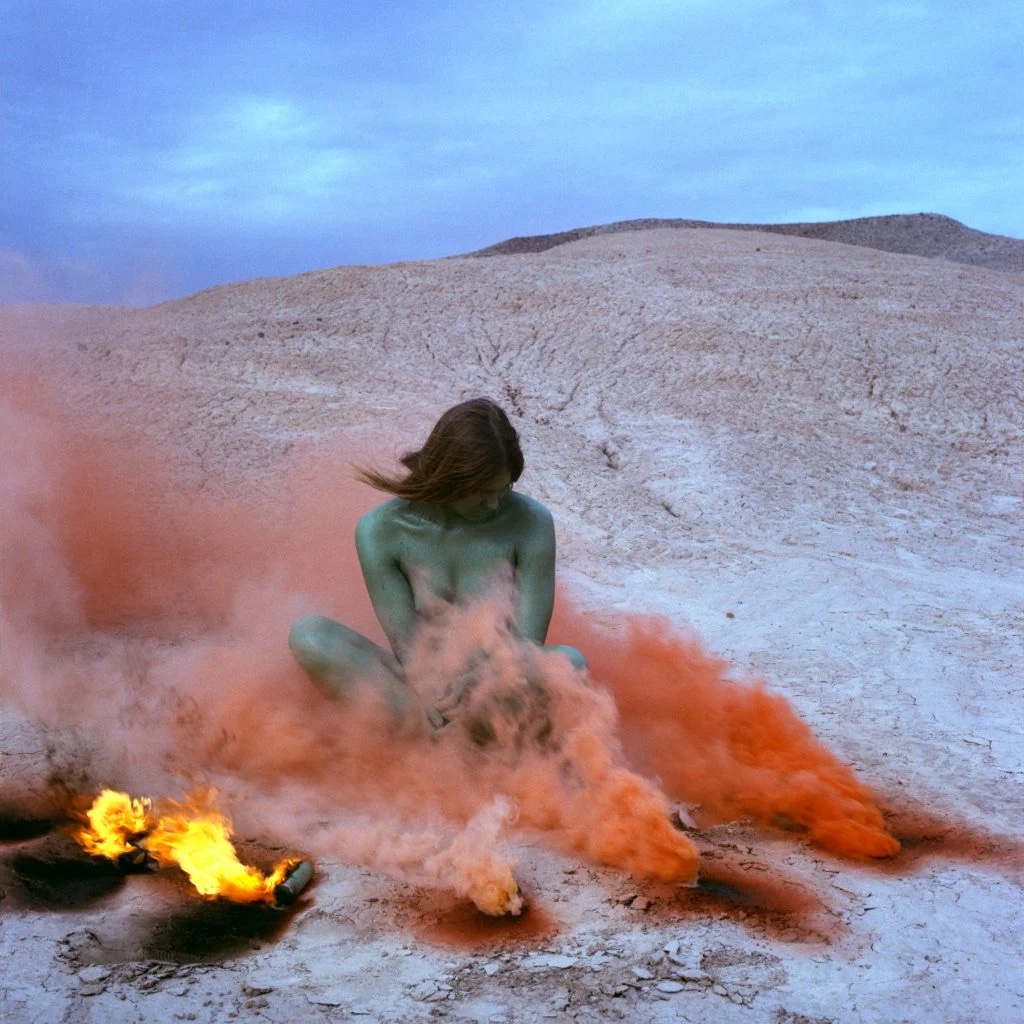 One room is dedicated to Atmospheres, a series of performances held in the desert in the early 1970s (pictured above: Immolation, 1972. Made in response to large scale earth works like Double Negative for which Michael Heizer extracted 244,000 tons of rock to create a huge canyon in Nevada, the films show performers letting off coloured flares. Instead of playing God by dominating the landscape, Chicago chose to collaborate with nature, mixing smoke “with the wind, the air and the sky” and leaving behind no traces.
One room is dedicated to Atmospheres, a series of performances held in the desert in the early 1970s (pictured above: Immolation, 1972. Made in response to large scale earth works like Double Negative for which Michael Heizer extracted 244,000 tons of rock to create a huge canyon in Nevada, the films show performers letting off coloured flares. Instead of playing God by dominating the landscape, Chicago chose to collaborate with nature, mixing smoke “with the wind, the air and the sky” and leaving behind no traces.
These were the last works she made in response to male initiatives. Realising she was never going to be accepted as “one of the boys”, Chicago began concentrating on what it means to be a woman artist and realised that, to gain traction, she would have to radically alter her own mind set and that of the male dominated art world.
She set up a Feminist Art Program with Miriam Schapiro at the California Institute of Arts and, in 1972, opened Womanhouse. Their students transformed an abandoned Hollywood mansion into a space for making and exhibiting art and, perhaps more importantly, for consciousness raising. "The aim”, Chicago explained, was “to help women restructure their personalities … and to help them build their art-making out of their experiences as women.”
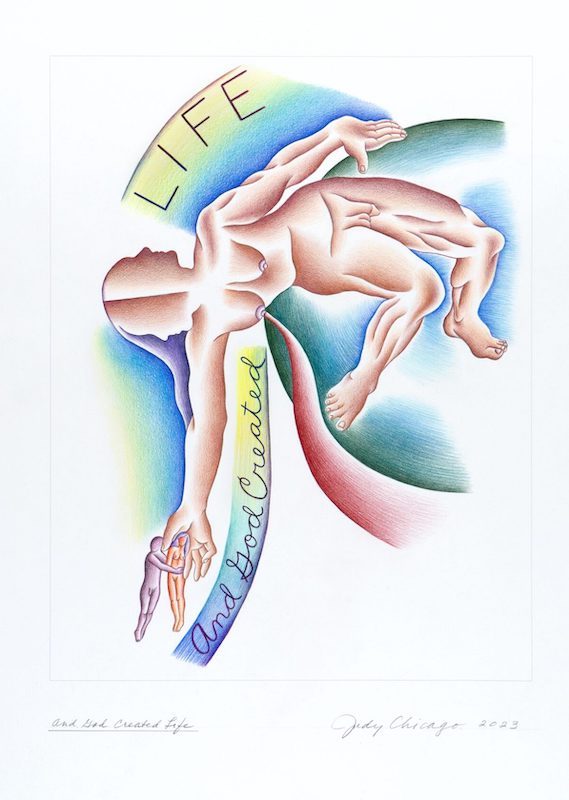 Since then she has gone her own sweet way, employing a huge variety of media, often collaborating with craftspeople and focusing mainly on women’s achievements, their erasure from history and their unrealised potential.
Since then she has gone her own sweet way, employing a huge variety of media, often collaborating with craftspeople and focusing mainly on women’s achievements, their erasure from history and their unrealised potential.
Five years in the making, her most famous work The Dinner Party involved nearly 400 people. Dubbed “vaginas on plates”, the triangular table is laid with 39 place settings featuring plates decorated with labial folds that celebrate actual and mythical women. And beneath the table are tiles commemorating a further 999 forgotten names. Housed in the Brooklyn Museum, it is too fragile to move so is described here on film by Chicago.
Revelations is the title of the show and of a book published to accompany it. This feminist retelling of the book of Genesis is based on a manuscript that lay forgotten in a drawer for 50 years. Chicago describes the creation of the world as a birthing. “Out of the chaos there emerged a sigh”, it reads, “and the sigh became a moan, and the moan became a wail, and the wail became the scream of birth.”
A vast drawing of the creation greets you on entering the gallery (main picture and detail below). Both a landscape and a woman’s body, it is inscribed with the words “her body rose up and her thighs became the mountains and her belly formed the valleys. Plants sprang up from her flesh, and living creatures crawled out of her crevices, and waters ran down her arms and formed the oceans and the rivers.”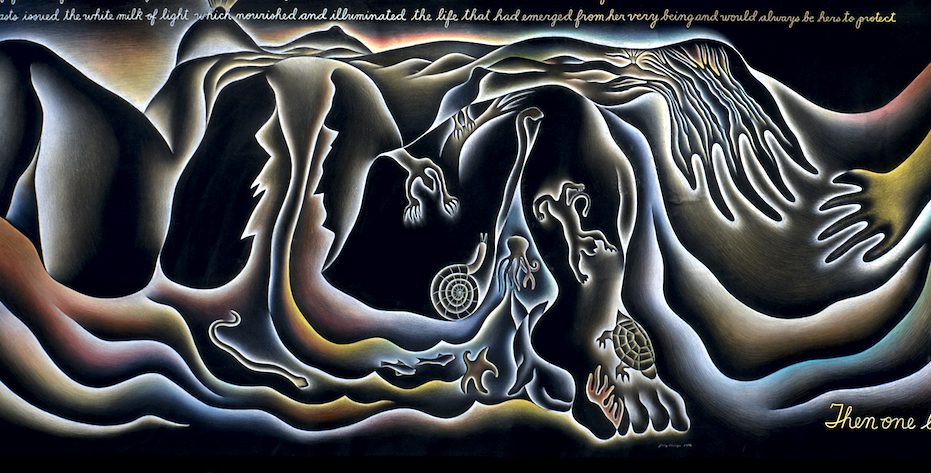 In the book the world is described as a paradise governed by women. Harmony reigns, as it does in her drawing And God Created Life (detail), 2023 (pictured above left), until the disgruntled men seize power, sew the seeds of dissent and rule the world by force. Chicago’s parable of the rise of patriarchy has a happy ending, though. The women teach the men to see the folly of their ways and persuade them to share power and resources and to honour nature. Her story ends on a rainbow-tinted double-page spread with the words: “And then everywhere was called Eden once again.”
In the book the world is described as a paradise governed by women. Harmony reigns, as it does in her drawing And God Created Life (detail), 2023 (pictured above left), until the disgruntled men seize power, sew the seeds of dissent and rule the world by force. Chicago’s parable of the rise of patriarchy has a happy ending, though. The women teach the men to see the folly of their ways and persuade them to share power and resources and to honour nature. Her story ends on a rainbow-tinted double-page spread with the words: “And then everywhere was called Eden once again.”
Judy Chicago is an optimist and a dreamer who thinks big and, like Yoko Ono, believes in the power of art to change the world – much as she changed her own fortunes through perseverance and sheer conviction.
If only things were that easy, the future would be bright and we could all live happily ever after.
- Judy Chicago: Revelations at the Serpentine Gallery to September 1
- More visual arts reviews on theartsdesk

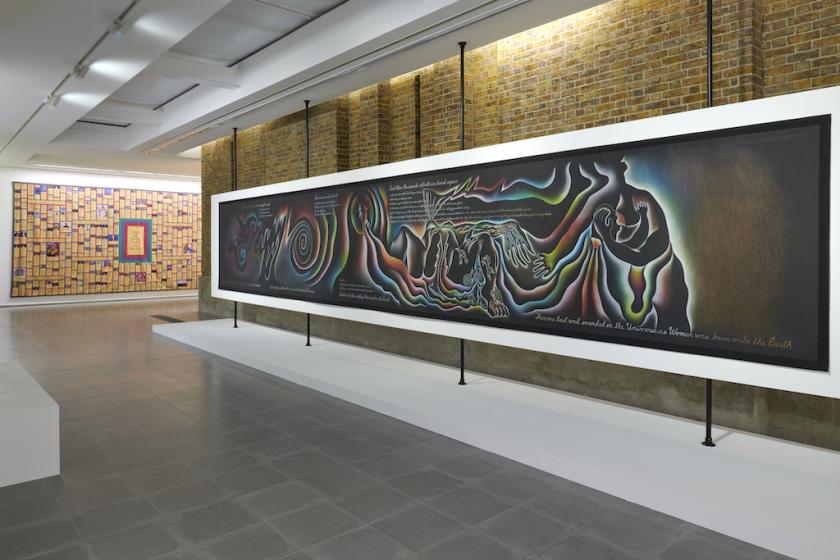







![SEX MONEY RACE RELIGION [2016] by Gilbert and George. Installation shot of Gilbert & George 21ST CENTURY PICTURES Hayward Gallery](/sites/default/files/styles/thumbnail_125_x_125_/public/mastimages/Gilbert%20%26%20George_%2021ST%20CENTURY%20PICTURES.%20SEX%20MONEY%20RACE%20RELIGION%20%5B2016%5D.%20Photo_%20Mark%20Blower.%20Courtesy%20of%20the%20Gilbert%20%26%20George%20and%20the%20Hayward%20Gallery._0.jpg?itok=3oW-Y84i)





Add comment